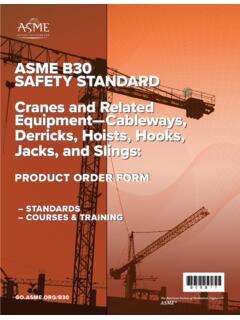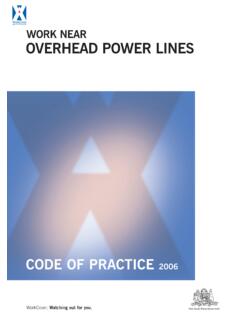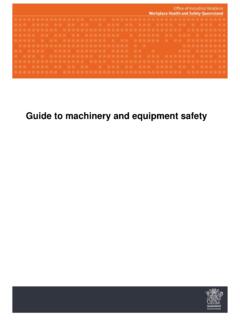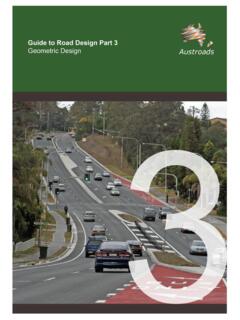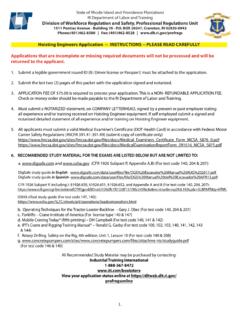Transcription of Rigging: Guide 1995 - The Riggers Pen
1 RIGGINGGUIDE 1995 WorkCover. Watching out for South Wales GovernmentA Guide to rigging Edited by David West Expert advice from Des Highfield, Ivan Bignold, Phil Court, Chris Turner, Barry Haines, Roy Cullen and Jack Campbell 1. rigging 2. Certification 3. Occupational health and safety Second edition 1997 DisclaimerThis publication may contain occupational health and safety and workers compensation information. It may include some of your obligations under the various legislations that WorkCover NSW administers. To ensure you comply with your legal obligations you must refer to the appropriate on the latest laws can be checked by visiting the NSW legislation website ( ) or by contacting the free hotline service on 02 9321 publication does not represent a comprehensive statement of the law as it applies to particular problems or to individuals or as a substitute for legal advice.
2 You should seek independent legal advice if you need assistance on the application of the law to your situation. WorkCover NSW1 ForewordThis competency Guide has been developed jointly by the WorkCover Authority of NSW and the Victorian WorkCover Authority. It is a major revision of the old and widely respected NSW publication, A Guide for Riggers . It has been structured to reflect the nationally uniform certificate classes for rigging and conform to the standards for rigging set out in the National OHS Certification Standard for Users and Operators of Industrial Equipment. The text is also consistent with the nationally uniform assessment instruments used by certificate assessors and a range of Australian Standards which cover equipment and work involved with rigging . This Guide is designed to be a useful reference for trainee Riggers , certificated Riggers , leading hands and rigging supervisors, training providers, certificate assessors, and government Manager WorkCover Authority of New South WalesChief Executive Victorian WorkCover Authority23 CONTENTS PAGEI ntroduction 5 PART ONE GENERAL rigging PRINCIPLES 71.
3 Flexible steel wire rope 82. Winches sheaves and purchases for flexible steel wire rope 253. Natural fibre rope and slings 374. Synthetic fibre rope and slings 485. Chain 556. Anchorages and fittings 627. General rigging appliances 728. Slinging and working loads 809. Selection and use of mobile cranes 9310. Packing, securing and moving loads 103 PART TWO BASIC rigging 10911. Steel erection 11112. Cantilevered crane loading platforms 12513. Erection of hoists and mast climbers 12814. Industrial safety nets 13415. Safety line systems 13816. Handling pre-cast concrete 143 PART THREE INTERMEDIATE rigging 14517. Tilt-up panels 14718. Multiple crane lifting 15319. Demolition rigging 15620. rigging cranes and hoists 164 PART FOUR ADVANCED rigging 17921. Fabricated hung scaffolds 18122. Suspended scaffolds 18423. Gin poles and derricks 19524. Span ropes and flying foxes 205 APPENDICES 209(i) Personal safety equipment and first aid 211(ii) Communication and signals 213(iii) Areas and volumes 215(iv) Tables of masses 219(v) Glossary 221(vi) Sample assessment questions 237 Index 24145 IntroductionRigging is work involving the use of mechanical load shifting equipment and associated gear to move, place or secure a load including plant, equipment or members of a building or structure and to ensure the stability of those members and the setting-up and dismantling of cranes and are four certificate levels involved in rigging : Dogging Basic rigging Intermediate rigging Advanced Guide outlines the competency based skills needed to carry out basic, intermediate and advanced rigging safety.
4 Basic rigging incorporates the skills needed for dogging. Refer to A Guide for dogging, WorkCover Authority of riggingThose qualified in basic rigging must know how to carry out work associated with: movement of plant and equipment steel erection particular hoists placement of pre-cast concrete safety nets and static lines mast climbers perimeter safety screens and shutters cantilevered crane loading riggingThose qualified in intermediate rigging must know how to carry out work associated with all basic rigging competencies and: the rigging of cranes, conveyors, dredges and excavators all hoists tilt slabs demolition dual riggingThose qualified in advanced rigging must know how to carry out work associated with all basic and intermediate rigging competencies and: the rigging of gin poles and shear legs flying foxes and cableways guyed derricks and structures suspended scaffolds and fabricated hung health and safetyUnder occupational health and safety legislation in each of Australia s states and territories: employers must provide and maintain equipment and systems of work that are safe and without risk to health employers must provide the correct equipment so that rigging work can be carried out safely employees must take care for the health and safety of themselves and fellow workers and cooperate with their employer while at guideThis Guide aims to.
5 Prepare readers to pass an examination for basic, intermediate and advanced rigging certificates provide the basic knowledge to help the reader to carry out rigging work safely be used as a reference book when carrying out rigging addition to covering all rigging competencies there is a Glossary of Terms , a set of Sample Assessment Questions and an index to assist the oneGeneral rigging principles8 Chapter 1 Flexible steel wire ropeIntroduction Flexible steel wire rope (FSWR) is the link between the crane and the hoist drum of the crane is the pulling mechanism which rotates, hauls in and stores surplus wire. The braking mechanism is connected to either the drum or the gearing which is joined to the drive wire passes over the head sheave of the crane and then down to the are many different types of lays and construction of FSWR to combat fatigue and abrasion, the two destructive forces which occur whenever FSWR is bent over a system of flexes as it bends over sheaves and drums.
6 As the wire bends over the sheave fatigue takes place. The outer wires are stretched and the inner wires are crushed against the sheave groove or drum. Wire never lays straight into the groove of a sheave because the load swings slightly or the rope vibrates. This causes friction or abrasion between the side of the sheave and the wire, wearing the outer wires of the strands. Flexible steel wire rope lays and construction FSWR is constructed of wires and strands laid around a central core. In the illustration below there are 19 wires to the strand and 6 strands around the core making up the rope. It is important not to confuse wires and strands. If a strand is broken, the rope is unusable. A single broken wire in a sling is not as important unless broken immediately below a metal fitting or anchorage. 9 The core can be: Fibre Core (FC) Independent Wire Rope Core (IWRC) Plastic Core (PC)The tensile strength of wire ranges from 1220 megapascals (MPa) to 2250 MPa.
7 The most commonly used tensile strengths are 17770 MPa and 1570 6/19 (six strands of 19 wires each) is the minimum FSWR construction that can be used for size of a rope is determined by its diameter. The smallest diameter FSWR that can be used for lifting is 5 is the direction the wires are formed into strands and the strands are formed into the finished strands can be laid either left or right around the core. In left hand lay the strands are laid anti-clockwise and in right hand lay they are laid lay is where the wires are laid in the opposite direction to the s lay is where the wires are laid in the same direction as the strands. There is therefore: Right hand ordinary lay RHOL Left hand ordinary lay LHOL Right hand Lang s lay RHLL Left hand Lang s lay LHLL10 Lay does not affect the working load limit of the rope but it does determine characteristics such as the spin of the s lay is used where both ends are fixed to prevent rotation such as for luffing.
8 It must not be used for lifting. (Inspection for birdcaging at the anchorage point must be done regularly.)Most general purpose ropes are right hand ordinary and post-forming Flexible steel wire ropes that are used as crane rope and for slinging are either pre- or post-formed. Pre-formed ropes have the spiral (helix) put in the individual wires before the wire is laid into the strand. Post-formed ropes are put through a series of off-set sheaves to bend the spiral into the individual wires after the rope is laid into the strand. Both pre-formed and post-formed ordinary lay ropes are more resistant than unformed or Lang s lay to unlaying when cut. Lang s lay FSWR Lang s lay is more flexible and harder wearing than ordinary lay ropes. It is used as excavator, dragline, and pile driving ropes where severe abrasion occurs. It is harder wearing because more of the individual wires are exposed to the sheaves.
9 Lang s lay has a tendency to unlay if it is used as a single fall crane rope because both wires and strands are laid up in the same direction into the rope. Pre- and post-forming make the rope easier to handle but it will still unlay under load. Ordinary lay FSWR Ordinary lay ropes are used extensively for slinging. They are more resistant to unlaying and have less wire exposed to sheaves because of the opposite spiral. They are also more resistant to crushing and kinking because of the very short length of exposed wires. Ordinary lay ropes are less resistant to abrasion than Lang s lay. Left hand lay FSWR A manufacturer may make up a FSWR with left hand lay strands on request. Left hand lay ropes are usually made for a special purpose. They will kink and twist when laying up into a purchase or system of sheaves if they are not laid up in the opposite direction to right handed lay.
10 Non-rotating ropes Under load all FSWRs have a tendency to unlay including pre- or post-formed and ordinary or Lang s lay. To prevent unlaying a left hand lay rope is layed inside a right hand lay rope. This is called a non-rotating ordinary lay rope and is usually used as crane rope. Under strain the opposite spiral in both the inner and outer layers are counter balanced and the rope does not twist. 11 Core slippage Non-rotating ropes require careful handling. If the outer strands slip or unlay slightly the core will protrude from the end of the rope. This is called core slippage. Core slippage can occur if the ends of the rope are not properly whipped before making a cut. Whippings of annealed wire must be put on either side of where the cut is to be made. The whippings should be put on with a serving mallet very tightly for a distance of at least 1 to 2 times the rope diameter each side of the cut for ropes to 24mm diameter and 4 times for ropes over 24mm diameter.
